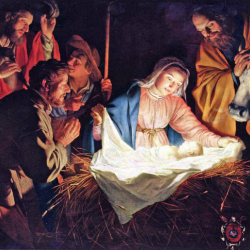A Short History of Christmas
12 December 2018 Hits:20650
The church didn’t celebrate the birth of Christ until the third century because no one knew (or could agree on) the date. It was highly unlikely for shepherds to be watching their flocks in the middle of a Northern Hemisphere winter. They were more likely to be doing that in Spring (or at least in warmer months). Still, the actual date of Jesus’ birth remains a mystery. For the first few centuries, the main celebration of the Christian church was Easter.
Historical Influences
In the fourth century, church officials decided to institute the birth of Jesus as a holiday. It was Pope Julius I who chose December 25 in an effort to engage with the culture of the day (December 25 was the birthday of Mithra, the god of the unconquerable sun. It was believed that Mithra, an infant god, was born of a rock. For some Romans, Mithra’s birthday was the most sacred day of the year). It was also the time of the Saturnalia festival – a holiday in honour of Saturn, the god of agriculture. According to history.com Saturnalia began in the week leading up to the winter solstice and continued for a full month. It was a hedonistic time when food and drink were plentiful – much like Christmas for many people today!
of Jesus as a holiday. It was Pope Julius I who chose December 25 in an effort to engage with the culture of the day (December 25 was the birthday of Mithra, the god of the unconquerable sun. It was believed that Mithra, an infant god, was born of a rock. For some Romans, Mithra’s birthday was the most sacred day of the year). It was also the time of the Saturnalia festival – a holiday in honour of Saturn, the god of agriculture. According to history.com Saturnalia began in the week leading up to the winter solstice and continued for a full month. It was a hedonistic time when food and drink were plentiful – much like Christmas for many people today!
In Scandinavia, the Norse celebrated Yule from December 21, the winter solstice, through January, in recognition of the return of the sun. In Germany, people honoured the pagan god Oden during the mid-winter holiday.
Christmas was first called the Feast of the Nativity. The custom spread to Egypt by 432 and to England by the end of the sixth century. By the end of the eighth century, the celebration of Christmas had spread all the way to Scandinavia. Today, in the Greek and Russian Orthodox churches, Christmas is celebrated 13 days after the 25th, which is also referred to as the Epiphany or Three Kings Day. This is the day it is believed that the three wise men finally found Jesus in the manger – if only they had a GPS!
By holding Christmas at the same time as traditional winter solstice festivals, church leaders increased the chances that Christmas would be popularly embraced, but gave up the ability to dictate how it was celebrated. By the Middle Ages Christianity had, for the most part, replaced pagan religion. On Christmas, believers attended church and then celebrated raucously in a drunken, carnival-like atmosphere.
Puritan Influences
In the early 17th century, a wave of religious reform changed the way Christmas was celebrated in Europe. When Oliver Cromwell and his Puritan forces took over England in 1645, they vowed to rid England of decadence and, as part of their effort, cancelled Christmas. In June 1647, a British Parliamentary ordinance abolished the feasts of Christmas, Easter and Whitsun. During the Christmas of 1647, a number of ministers were taken into custody by the authorities for attempting to preach on Christmas Day. But good sense finally won out over religious fundamentalism and King Charles II restored Christmas in 1660.
Current Influences
Two books have heavily influenced our current Christmas celebrations: Washington Irving’s The Sketchbook of Geoffrey Crayon, Gent (1891) – a series of stories about the celebration of Christmas in an English manor house. Irving focused on Christmas being a peaceful, warm-hearted, family-centered holiday bringing groups together across lines of wealth or social status.
Also around this time, English author Charles Dickens published his classic book, A Christmas Carol. The story’s message was the importance of charity and good will towards all humankind and struck a powerful chord in the United States and England showing members of Victorian society the benefits of celebrating the holiday.
Over the past few decades, some old traditions were added to the “new” view of Christmas presented by Irving and Dickens – people started decorating trees, sending holiday cards and giving gifts.
And that’s how we find Christmas today. In Australia, we have the idea that we celebrate Christmas as it has been done for centuries but that’s not right. Thanks to two books we’ve really re-invented a holiday to fill a cultural need of a growing nation – and it’s a wonderful time for Christians to engage with culture.
 Hospitality, generosity, sharing food together, spending time with family and friends and helping those less fortunate are all amazing ways to live out our faith in Jesus. And even though Jesus was probably not born on December 25th the important thing is He was born – God came to earth as a flesh and blood person to show us what He is really like – and that’s worth celebrating!
Hospitality, generosity, sharing food together, spending time with family and friends and helping those less fortunate are all amazing ways to live out our faith in Jesus. And even though Jesus was probably not born on December 25th the important thing is He was born – God came to earth as a flesh and blood person to show us what He is really like – and that’s worth celebrating!
Photograph Credit: Mithra, taken by Carole Raddato from FRANKFURT, Germany.

Rob Buckingham
Senior Minister




5 replies on “A Short History of Christmas”
Thank you so much, Ps. Rob, for clearing up quite a few puzzling things about Christmas. Just one little query, though, about the three Wise Men / Kings who brought the gifts of gold, frankincense and myrrh several days after the actual birth. If they came from the East, wouldn’t the Star they were following have been in a westerly direction? This has always got me thinking….probably not that important anyway! And would the baby Jesus still have been lying in a manger (food trough) after so many days…?
I’m thinking that star those Magi were following was perhaps a supernatural gift of God for those seeking the King of Kings. The Child and the house tells me that it could have been many weeks since the manger birth. Since God sent an angel several times to Joseph and Mary, he could certainly direct a special star to the Christ Child.
Regarding the star in the east. It’s says “We saw His star in the east…” It could be when they were in the east they saw his star.
Candles are a picture that Christ is the Light of the world (John 8).
Holly speaks of the thorns in His crown (Matthew 27:29).
Red is a color of Christmas that speaks of Christ’s blood and death.
Gifts are a reminder of the gifts of the Magi to baby Jesus. Each of them speak to a component of His incarnation: Majesty in life, Bitterest Agony in Death and He as God’s Perfect gift to us (Matthew 2).
If the Jesus’ ministry lasted 3.5 years, at his baptism His age was about 30, and He died in what today is March or April, His birthday would have been about six months earlier: what today is September or October.